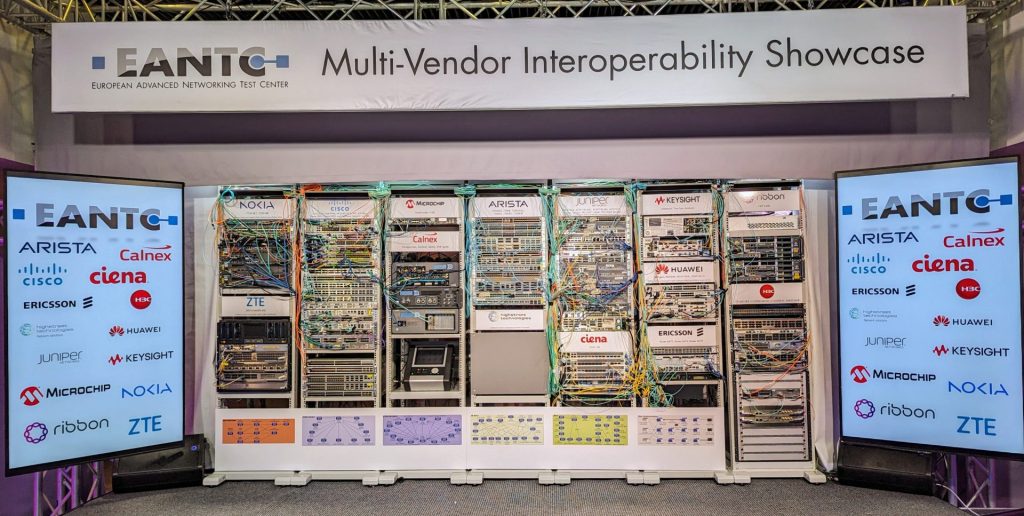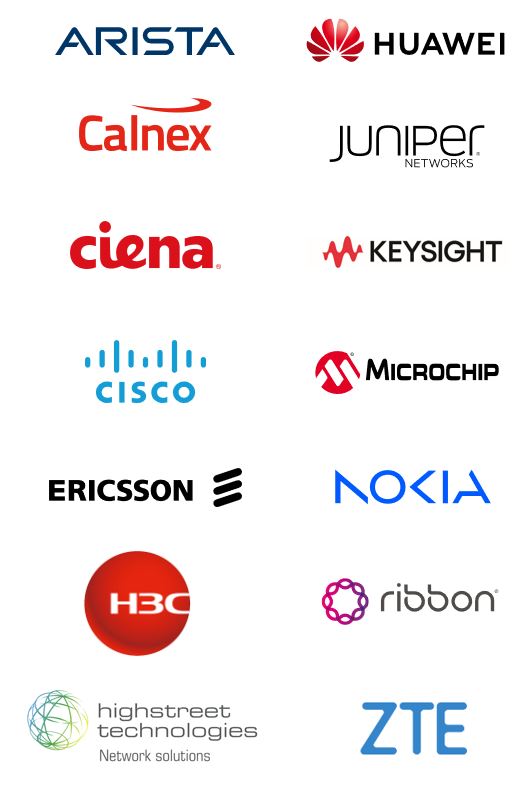Multi-Vendor MPLS SDN Interoperability Test 2024

We are excited to announce the completion of EANTC’s Multi-Vendor Interoperability Test 2024 focusing on SDN, Segment Routing, EVPN, and Time Synchronization. This event was conducted in collaboration with Upperside Conferences.
The 2024 test event covered 5G transport networks implemented in mobile network fronthaul and backhaul, end-to-end transport network slicing, traffic engineering, and packet network synchronization.
We verified cloud networking and service assurance. Multiple transport domains such as WAN, data centers, metro edge, and IP/optical convergence solutions were also integrated. EANTC focused on validating application-specific quality, resiliency, and policy-based networking including Flex-Algo.
Arista, Calnex, Ciena, Cisco, Ericsson, H3C, highstreet technologies, Huawei, Juniper, Keysight, Microchip, Nokia, Ribbon, and ZTE jointly executed extensive tests at EANTC’s Lab in Berlin, Germany. More than 80 engineers from these 14 leading vendors teamed up on-site to validate the interoperability and integration of more than 130 devices.
The testing probed the innovations in transport network solutions to support business VPN and 5G network services with application-specific network policies. The event covered 87 test scenarios, and more than 1,590 result datasets (number of test cases and results were up 30 % from last year) were created and thoroughly validated by EANTC.

A 64-page detailed test report is freely available online on this page, with a level of technical detail sufficient to understand and, if needed, reproduce the tests conducted at EANTC.
In detail, the latest innovations in the following technology areas were covered:
EVPN
- Flexible Cross-Connect Service
- EVPN-VPWS with Pseudowires virtual Ethernet Segment (vES)
- Proxy MAC-IP Advertisement
- Preference-Based EVPN Designated Forwarder (DF) Election
- EVPN Port-Active Redundancy
- EVPN Layer 2 Attributes Extended Community
- Weighted Multipath Procedures for EVPN Multi-Homing
- IP Prefix Resolution to Gateway IP
- EVPN IGMP-Proxy
- Symmetric and Asymmetric Integrated Routing and Bridging (IRB)
- MAC Mobility
- EVPN-VXLAN Tunnel Stitching for Data Center Interconnect (DCI)
- Multi-Site EVPN Overlay Interworking
- EVPN Interworking between VXLAN and SR-MPLS
- EVPN/IPVPN Interworking
- EVPN VXLAN with IPv6 VTEPs
- Optimized Inter-subnet Multicast Forwarding (OISM)
Segment Routing
- L3VPN services interoperability over SR-MPLS and SRv6 using compressed Segments IDs (µSID)
- L2VPN, EVPN VPWS, RT5, and EVPN ELAN Single Homing/Multi-Homing over SRv6
- Inter-Autonomous System (AS) Option C multi-provider interworking, using Anycast Next Hops
- Per-Destination Segment Routing Traffic Engineering (SR-TE) Traffic Steering
- SR-MPLS Policy Liveness (fault detection and self-healing)
- Router/Optical Transmission Interworking using 400ZR/ZR+ optics
- SR-MPLS and SRv6 Flexible Algorithms with Average Delay, TE, Minimum Bandwidth, Maximum Delay, and Exclude Node/Exclude Reverse metrics
- Topology-Independent Loop-Free Alternate (TI-LFA) over SR-MPLS and SRv6, including observance of Flexible Algorithms
- SR-MPLS with IPv6 Control Plane
- Bit Index Explicit Replication (BIER) multicast
- Global IPv4/IPv6 Routing table support and Prefix Summarization over SRv6
- SRv6 Unreachable Prefix Announcement (UPA)
- SRv6 TE Policies with Explicit Paths
- SRv6 and SR-MPLS Service Interworking
- SRv6 Resource Slicing
- SRv6 Path Tracing
- Multicast Source Routing over IPv6 (MSR6)
SDN
- Colored SR-MPLS and SRv6 Policy
- PCC-Dynamic Paths Instantiation
- Advertisement of SR Policies using BGP-LS
- PCEP over IPv6
- Latency-Based Optimization
- Flexible Algorithm Discovery and Visualization
- SRv6 µSID Topology Discovery and Visualization
- PCEP Association Group: Diversity and Policy
- PCEP Binding SID
- NETCONF Transport Slicing Controller
- L2VPN (including Multipoint) and L3VPN Provisioning
- Telemetry (gNMI)
Time Synchronization
- Boundary Clock Class C and Class D Conformance
- Time Synchronization Source Failover
- Holdover with Enhanced SyncE Support
- Calculating Time Error Limits for Boundary Clocks
- Delay Asymmetry Detection and Measurement
- Boundary Clock Interworking Function Performance
- Passive Port Monitoring
- O-RAN Fronthaul Synchronization LLS-C2 and LLS-C3
- PTP over DWDM Line System
- Multi-Boundary Clock Holdover
The EANTC team highly appreciates the outstanding commitment of all participating vendors to standards-based solutions and independent, transparent interoperability verification.

